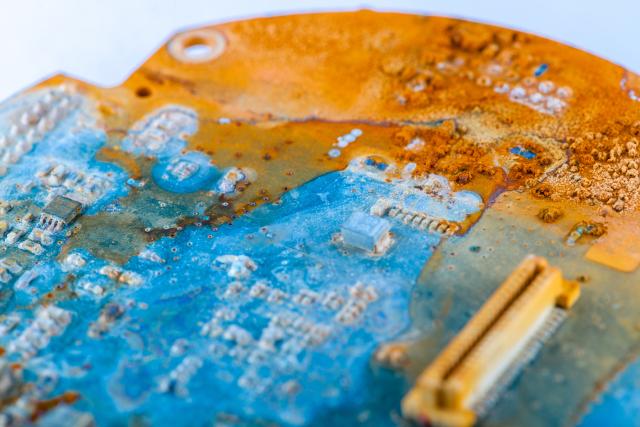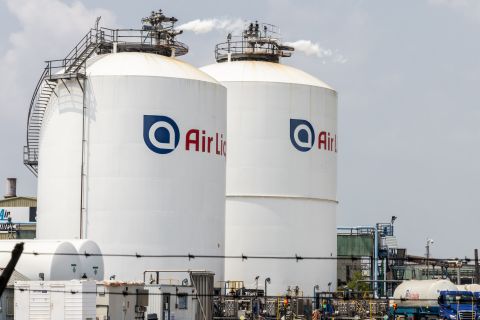
Protective nano-coatings safeguard electronics from the most demanding corrosive and liquid environments. (Source: HZO Inc.)
Although the oil and gas industry has long endured a reputation for suspicion of change and innovation, today nothing could be further from the truth.
To attain a competitive advantage, companies must produce crude oil and LNG more efficiently and at lower costs, which is driving innovation. Stakeholders are invested in enhancing and extending the value of their current assets while searching for new reserves in locations that comprise high-geothermal gradients, exposing drilling operations to extreme temperatures and pressures. Meanwhile, increasingly stringent environmental regulations that require transparency in operations and tighter controls on production and distribution add to the complexity of the industry evolution.
Upstream and downstream processing companies are embracing a growing number of digital solutions and new IT and operational technologies to meet the need for greater efficiency and cost-cutting, and the Industrial Internet of Things (IIoT) has risen to the top for workload optimization, predictive maintenance and asset management.
With improved connectivity, cheaper sensors, energy storage technology and the availability of distributed power platforms, oil and gas companies are increasing the use of smart sensors and rugged digital endpoints in more places to monitor machinery and environmental conditions—especially on the “edge” where data bridges from infrastructure to device.
Culprits of failure
Edge computing offers the promise of real-time data, which helps drive better decision-making and industrial processes, but the operating environment has its challenges. There are wellbores thousands of feet underground, millions of miles of pipelines across the U.S., extreme temperatures in LNG, complex refining processes and many configurations in processing terminals. These distributed environments have traditionally seen an increase in data latency and reactive operations that edge and IIoT mitigates.
The problem is that networks are only as good as their weakest links. No matter how good the network is, they cannot transmit data or do so inaccurately if the connected devices are damaged. The failure of a single device can have devastating consequences. The biggest culprits of failure are chemicals, liquids, abrasions, weather, microorganisms and extreme temperatures.
Many electronic device designers that provide components to the oil and gas industry are moving away from using standard multiple-layer FR4 board configurations, a standard defined by the National Electrical Manufacturers Association for a glass-reinforced epoxy resin laminate, to using more flex materials for interconnects (e.g., polyimide, thermoplastics or transparent conductive polyester films).
These configurations have been historically challenging for protective coatings, often requiring some form of a protective case or shield.
Thin-film conformal solutions
Parylene thin film coatings protect even the most intricate flex circuit design and eliminate the need for alternative protection. Connectivity product manufacturers, including radio and chipset makers, platform vendors, device manufacturers and those that purchase IIoT-enabled products, are turning to thin-films and nanocoatings to maintain device reliability and uptime across IIoT landscapes.
Thin-film conformal solutions, including Parylene, are time-tested with excellent protective properties that meet the design and functionality of industry-standard requirements for the oil and gas industry. These coating materials create barriers to moisture, chemicals, temperatures and biological agents. The coatings also offer low-dielectric constants and dissipation factors, and they enable component fidelity, an essential asset in applied electrical and fiber-optic interconnect systems.
When applied appropriately, Parylene conformal coatings provide superior protection for the internal circuitry of IIoT sensors and devices. Chemical vapor deposition, the application deposition process for Parylene, creates a uniform, pinhole-free conformal coating thickness that penetrates the hardest to reach crevices of complex circuitry.
Rather than building a protective assembly and sealing it around a device, Parylene protects flex-circuit configurations and many other devices and substrate materials from the inside out.
Conclusion
Data is the oil and gas industry’s most valuable resource. Whether electronics, circuit boards and sensors are located above the drill bit, on the drillstring itself or subsea, reliability is highly critical. With data volumes that exceed 10 TB per day for a single well, mission-critical information needs to be consumed by operators quickly and accurately for crucial decision-making.
Unplanned downtimes bring unnecessarily high costs and exposure to unnecessary risks. Implementing digitalization and IIoT technologies are preventive actions that can reduce unplanned downtime.
Parylene coatings, with their insulating, dielectric and protective properties, offer several advantages for use on electronics. It is the preferred strategy for achieving maximum equipment and process uptime, extending the useful life of equipment and optimizing the total cost of ownership.
To maintain the integrity of the information derived from the vast array of physical equipment that runs the oil and gas industry, newer, smarter devices are required for applications that can withstand the environmental risks associated with the industry itself.
Editor's note: Marco Machi is the senior director of sales and business development with HZO Inc. He has 20-plus years of experience in energy and industrial automation with ABB and Hitachi.
Recommended Reading
Baker Hughes Awarded Saudi Pipeline Technology Contract
2024-04-23 - Baker Hughes will supply centrifugal compressors for Saudi Arabia’s new pipeline system, which aims to increase gas distribution across the kingdom and reduce carbon emissions
Air Products Sees $15B Hydrogen, Energy Transition Project Backlog
2024-02-07 - Pennsylvania-headquartered Air Products has eight hydrogen projects underway and is targeting an IRR of more than 10%.
Air Liquide Eyes More Investments as Backlog Grows to $4.8B
2024-02-22 - Air Liquide reported a net profit of €3.08 billion ($US3.33 billion) for 2023, up more than 11% compared to 2022.
From Restructuring to Reinvention, Weatherford Upbeat on Upcycle
2024-02-11 - Weatherford CEO Girish Saligram charts course for growth as the company looks to enter the third year of what appears to be a long upcycle.
TechnipFMC Eyes $30B in Subsea Orders by 2025
2024-02-23 - TechnipFMC is capitalizing on an industry shift in spending to offshore projects from land projects.





